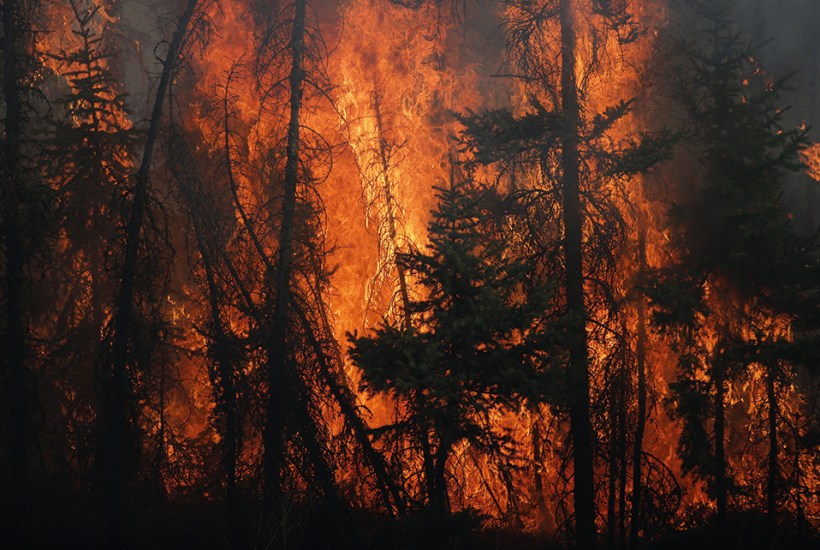In the light of recent fire emergencies on the Greek islands and in the wider Mediterranean, this book has just acquired even more relevance. It centres on another catastrophe in May 2016, a Canadian inferno nicknamed the ‘Beast’, which has become the most expensive natural disaster in the country’s history.
Within five days of its discovery, the blaze had forced the mass evacuation of 90,000 residents from the city of Fort McMurray in Alberta Province. In just three weeks, egged on by an El Niño cycle as well as fierce winds and record temperatures across America’s subarctic belt, it had incinerated an area equal to the county of Cumbria. The resulting firestorm of 760°C vaporised 2,500 homes and released 100 million tonnes of CO2 into the atmosphere.
John Vaillant unfolds these fateful days in all their hellish detail. Ironically, for me they entail one lack of judgment in an otherwise flawless book. The author is compelled by Fort McMurray’s burning too completely. His cast of characters narrating the emergency is large, and I found the geography of the city’s suburbs hard to navigate or visualise. That closeness to the action includes a lot of verbatim testimony from eyewitnesses. Here are two snippets from the same page:
Palmer told me, ‘but this fire – it was kind of like, Okay guys, throw the textbooks in the fire because that’s as good as they are right now.’
‘Okay now I know where I got to go and what I got to do.’ But beyond that, it was just – whatever.
Rather than increasing clarity or tension, such dialogue introduces a degree of banality to life-and-death events. To use a cinematic metaphor, Vaillant’s disaster movie is instantly elevated the moment he pans back from the minutiae to consider the wider landscape. What makes Fire Weather so good is its in-depth analysis of the moral, political, environmental and even anthropological background to both the climate crisis and our relationship with fire in all its forms.
From the smoke-filled caves of the earliest hominids to the ‘Petrocene’ of our times (Vaillant’s term for our 200-year love affair with industrial coal, oil and gas), he explains how fire has long been an almost defining characteristic of our species, and the decisive factor in our recent economic ascendancy and ecological dominance. That we have now come to such a pass seems ingrained in our DNA.
In exploring the wider implications of the events at Fort McMurray, Vaillant makes clear that its $10 billion price tag may be the least remarkable of its features. What is indisputably significant, to illuminate our present unpreparedness vis-à-vis climate change, is that just days before the Beast’s devastating career, it had been judged a minor brushfire beyond the city limits. It wasn’t that the region’s otherwise crack fire service lacked professionalism. The author explores a key part of their oversight which afflicts all of us: a profound failure of imagination when confronted by exceptional evidence.
He also considers a paradox identified by the Roman philosopher under whose name it has acquired fame – the Lucretius Problem. This proposes that people don’t assimilate the size and significance of phenomena until they have directly encountered something comparable. Our future world of climate chaos will always take us by surprise, because the only measure we accept has been in the past. When matters are unprecedented we are lost.
A distinguishing feature of the book is its even-handed presentation of the evidence and Vaillant’s refusal to judge or preach. Yet he makes plain that there are villains as well as heroes in his wider story. It is not only that unresponsive politicians and climatologists have been in a 70-year, ever-intensifying exchange. The oil companies first embraced the scientific implications of their trade, then deliberately polluted the debate with falsehood. An estimated $100 million was spent by them on cynical persuasion.
Its lasting legacy is powerfully illuminated even after the events at Fort McMurray. The city is at the heart of the tar sands reclamation industry. To access this low-grade fuel requires 350,000 barrels of oil a day, making it the largest, most expensive energy-intensive recovery project on Earth. The fire of May 2016 did at least pull the rug from beneath those working in the tar sand business. Yet, rather than confront the underlying realities, Alberta’s premier threatened to shame oil companies or banks divesting from bitumen extraction.
In 2021, 62 per cent of the delegates at Alberta’s United Conservative party convention voted against a proposal to include climate-related language in its policy book. They prefer to bury their heads in tar sands. If we are to lift up our eyes and embrace the truth, then we all need to heed this powerful book.
Got something to add? Join the discussion and comment below.
Get 10 issues for just $10
Subscribe to The Spectator Australia today for the next 10 magazine issues, plus full online access, for just $10.
You might disagree with half of it, but you’ll enjoy reading all of it. Try your first month for free, then just $2 a week for the remainder of your first year.














Comments
Don't miss out
Join the conversation with other Spectator Australia readers. Subscribe to leave a comment.
SUBSCRIBEAlready a subscriber? Log in